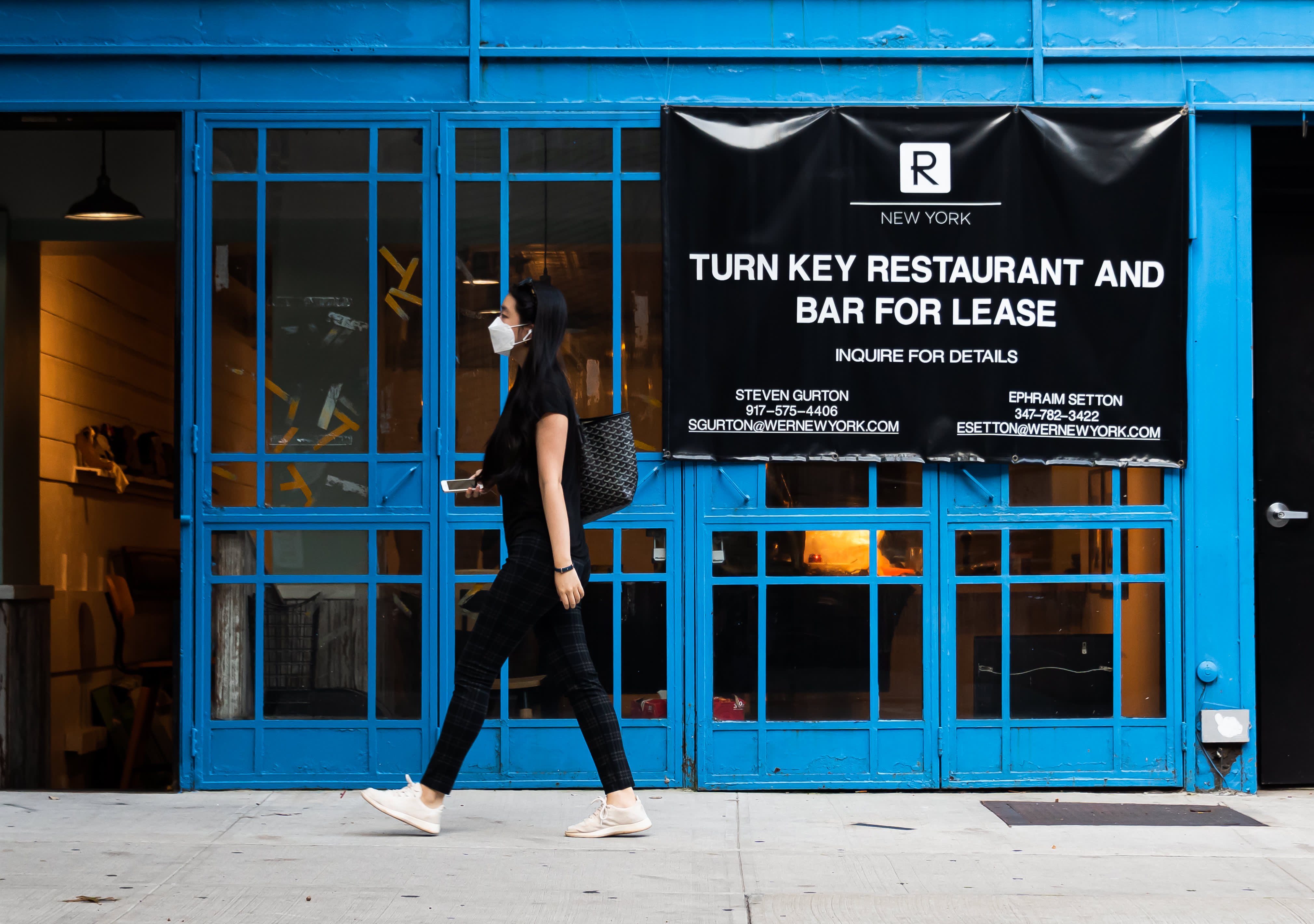On October 21, 2020 in New York City, a pedestrian walks by a closed restaurant in Gramercy as the city continues its re-opening efforts following limitations set to slow the spread of coronavirus. Getty Images/Noam Galai New York City restaurateurs are signing new leases due to a glut of unoccupied space fully equipped with kitchen appliances and the opportunity to take advantage of historically inexpensive rents. According to commercial real estate services firm CBRE, food and beverage tenants were the most active in negotiating retail deals across Manhattan during the second quarter ending June 30. Some, like Flex Mussels, are making a comeback after the industry was crushed by last year’s indoor dining restrictions. The seafood restaurant will relocate one block from its pre-pandemic Upper East Side location to a 4,500-square-foot, two-story facility that will be left by a Turkish restaurant in 2020. Since March 2020, more than a tenth of U.S. restaurants, or around 80,000 out of about 779,000, have closed permanently, according to industry tracker Datassential. Other companies see the chaos as a chance to break into the industry for the first time. Mezeh Mediterranean Grill, a Greek-inspired restaurant chain established in Annapolis, Maryland, has just signed its first lease in Manhattan. CBRE said that La Casa Del Mofongo, a Latin restaurant and nightclub, has secured a 10-year lease for a 15,000-square-foot building near Herald Square. It was the largest food-and-beverage deal for the quarter in terms of magnitude. Sweetgreen, a salad business, and Shake Shack, a burger eatery, have both announced new locations. The former is preparing for an initial public offering to fund its expansion goals, while the latter wants to launch up to 40 new restaurants in the United States this year. According to CBRE, restaurant brands completed 23 transactions in Manhattan in the second quarter, totaling 83,333 square feet of space. With ten leases totaling 49,236 square feet, apparel businesses were the second most active group. Health-care providers and jewelers came in second and third, respectively, with two transactions each. “Our communities’ density is still very, very robust,” said David LaPierre, vice chairman of CBRE’s global retail services division. “Right now, restaurants are really crowded. I’m quite busy. As a result, a lot of that deal-making is opportunistic because… people are more focused on the long-term recovery.” While Manhattan’s retail real estate market is still struggling, a rush of restaurant deals gives hope. The Covid health problem effectively turned one of the world’s busiest retail centers into a ghost town. According to CBRE’s analysis of 16 main retail corridors in Manhattan, leasing velocity has slowed for eight consecutive quarters. During the second quarter, the number of direct ground-floor availabilities grew to 290, up from 275 in the previous quarter. According to CBRE, retail space availability is at an all-time high. The average asking retail rent dropped 10.7% year over year to $615 per square foot, the 15th straight quarterly decrease. According to CBRE, rent rates are at their lowest point in nearly a decade. Landlords, for their part, are using a number of strategies to sweeten the deal in order to fill empty storefronts. According to CBRE’s brokers and analysts, concessions such as significant tenant improvement allowances, free rent periods, and percentage-rent packages are “key talking topics” in the Manhattan retail market today. On May 28, 2021, a woman passes past a closed retail store in New York City’s Flatiron area. Reuters’ Shannon Stapleton Spring Street in SoHo saw the greatest year-over-year decrease of the 16 corridors, with rents falling 22.9 percent to $487 per square foot in the second quarter. Rents in Times Square, which has been hit hard by a lack of tourists, have plunged 22.5 percent to $1,277, the lowest level CBRE has observed since 2011. Rents around Grand Central, a corridor frequented by office commuters prior to the pandemic, dropped 10.4% to $675 per square foot. According to Jason Pruger, an executive managing director at the real estate business Newmark, the dynamic should improve when people return to work and overseas tourism recovers. Some of the recent acquisitions he’s been following are from businesses that already have a presence in the city, such as restaurants, that view the available space as an opportunity to expand without having to do significant building work. “Manhattan is made up of three things: individuals who live here, tourists who come here, and the office population that comes in from the suburbs,” Pruger, who works in Newmark’s midtown office, explained. “For Manhattan to be Manhattan, all three must be in sync.” During the quarter, the SoHo neighborhood saw the most new transactions, as low rents and returning customers attracted a range of retail tenants. During the second quarter, CBRE tracked 13 acquisitions in SoHo, totaling 47,332 square feet of commercial space. Vashi, a British fine jewelry firm, was one of them, having signed its first-ever lease in the United States. Two deals totaling 31,622 square feet were completed in the Plaza District along Fifth Avenue, which stretches from 49th to 59th Street. Along the famed strip of high-end stores, the Spanish fashion company Mango is taking over Ralph Lauren’s previous 28,000-square-foot flagship building. “Rents are still under downward pressure,” LaPierre explained. “It depends on the market.” “When are we going to hit that leveling off?” he inquired. “Increased number of people working in the workplace. More people during the day. More tourism is needed… When we start seeing that, the line will most likely flatten down a little more before ascending again.” Amelia Lucas of CNBC contributed to this article./n
Read MoreNew York’s retail rents set another record low, but restaurants are starting to sign leases again
2021-07-15T12:00:53-04:00July 15th, 2021|





